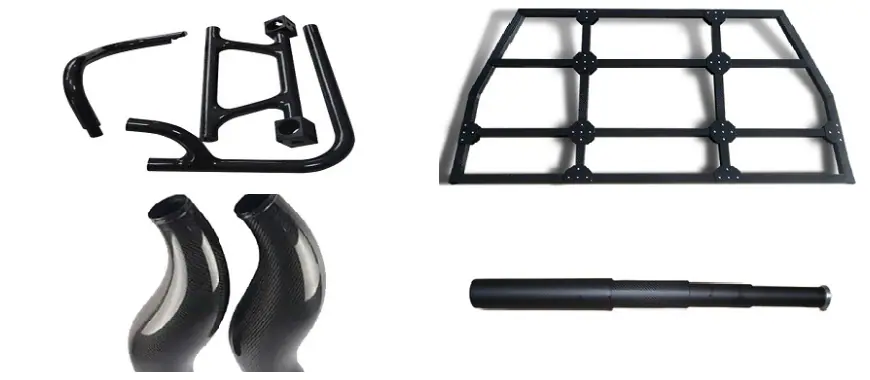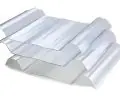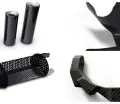
White carbon fibers is a unique variation of traditional carbon fiber, where the standard black appearance is replaced by a striking white finish. This transformation is achieved through specialized resin formulations or coatings that give the material its distinctive color while maintaining the exceptional properties of carbon fiber. White carbon fibers combines the lightweight, strength, and durability of its black counterpart with a sleek, futuristic aesthetic. Its growing popularity can be attributed to its eye-catching appearance and its versatile applications in high-end vehicles, motorsports, and custom designs. As more industries explore its potential, white carbon fiber continues to make a bold statement in both performance and style.
Applications of White Carbon Fiber
White carbon fiber is increasingly being utilized across various industries, especially in sectors where both performance and aesthetics play key roles. Its lightweight yet durable properties make it a preferred material for high-end applications, while its sleek white finish gives it a futuristic, premium appearance. Below, we explore the diverse applications of white carbon fibers in the automotive industry.
White Carbon Fiber in Cars
Car Body Parts
White carbon fibers is frequently used in high-end sports cars and custom-built vehicles to enhance both aesthetics and performance. Manufacturers are incorporating white carbon fibers into various body parts such as side skirts, fenders, and bumpers, not only for their visual appeal but also to reduce the overall weight of the vehicle. This material offers the same superior strength and lightweight qualities as traditional black carbon fiber but with a more distinct and stylish look. For example, Koenigsegg, a leading manufacturer of hypercars, is known for using white carbon fibers in their vehicle designs, showcasing its potential in the luxury car market.
White Carbon Fiber Hood
One of the most popular uses of white carbon fibers in cars is in the construction of vehicle hoods. White carbon fibers hoods are prized for their ability to reduce the weight of the car without compromising on strength. This weight reduction is critical in high-performance cars, where every kilogram saved can lead to improved acceleration and handling. In addition to the performance benefits, the striking visual appeal of a white carbon fibers hood enhances the vehicle’s sleek, modern appearance, making it a sought-after feature among automotive enthusiasts.
White Carbon Fiber Spoilers
White carbon fibers spoilers serve dual purposes in performance vehicles. Firstly, they improve aerodynamics by providing greater downforce, which helps stabilize the car at higher speeds. Secondly, the use of white carbon fibers gives the spoiler a distinctive, high-tech look that complements the overall design of sports and concept cars. This combination of function and style makes white carbon fibers spoilers a popular choice for cars designed to push the limits of performance and innovation.
White Carbon Fiber Wrap
For those seeking the aesthetic of white carbon fibers without the high cost, a white carbon fibers wrap is a popular alternative. This material can be applied to various sections of a vehicle, such as the hood, roof, mirrors, or door panels, to give the car a carbon fiber appearance. White carbon fibers wraps are a more affordable option for those who want to achieve the premium, futuristic look of white carbon fibers while avoiding the expense of solid carbon fiber parts. The wrap offers similar visual appeal but with the added flexibility of being easily replaced or removed.
Carbon Filler Fiberglass: Best Solutions for Composite Repairs
White Carbon Fiber in Other Industries
While white carbon fiber is most commonly associated with the automotive industry, its unique properties and aesthetic appeal have made it a sought-after material in several other sectors. Industries ranging from sports equipment to personal items are exploring the potential of white carbon fibers to enhance both functionality and design. Below, we explore how this material is being applied in different fields.
White Carbon Fiber Shafts
One of the more notable applications of carbon fiber white is in the production of high-performance shafts used in sports equipment. Golf clubs and fishing rods, for instance, benefit greatly from the material’s lightweight yet durable qualities. White carbon fiber shafts are favored for their ability to enhance performance by reducing the overall weight of the equipment while maintaining the strength necessary for optimal functionality. In golf, the reduced weight allows for quicker swing speeds, improving accuracy and distance. Similarly, in fishing, the lightweight nature of white carbon fiber provides anglers with better sensitivity and control, making it easier to feel the fish’s movements and make precise casts. The material’s strength ensures that these shafts can withstand the repetitive stresses of high-impact activities without breaking or degrading over time.
White Carbon Fiber Wrap 3M
In addition to solid white carbon fibers parts, wraps made from white carbon fibers are becoming increasingly popular. Companies like 3M offer white carbon fibers wraps, allowing individuals and businesses to customize various products without the full commitment of solid carbon fiber components. These wraps are especially popular in the automotive and technology sectors, where they can be applied to vehicles, tools, or personal items like laptops and smartphones. The primary advantage of using a white carbon fibers wrap is its affordability, offering the aesthetic appeal of the material without the high cost associated with solid carbon fiber. These wraps are easy to apply and can be removed or replaced as needed, making them a versatile option for anyone looking to achieve the futuristic, high-tech look of white carbon fibers without permanent changes.
Fiberglass Repair Carbon Fiber: Best Kits and Materials
Manufacturing Process of White Carbon Fiber
The production of white carbon fibers involves a set of unique techniques that differ from those used in traditional black carbon fiber manufacturing. This process ensures that the material retains its strength, flexibility, and lightweight properties while introducing a distinct white color. Let’s explore the key aspects of how white carbon fibers is made.
Resin and Coating Techniques
One of the primary differences between white carbon fibers and traditional carbon fiber is the resin or coating system used to give the material its white appearance. Unlike black carbon fiber, which uses standard resin systems that do not affect the color of the fibers, white carbon fibers requires specialized resin formulations or coatings. These resins are carefully selected to not only provide the desired color but also maintain the critical properties of carbon fiber, such as strength, flexibility, and durability.
In some cases, a layer of white coating is applied over the carbon fiber structure, which gives the material its distinct white finish. These coatings are designed to bond seamlessly with the carbon fiber, ensuring that the final product does not lose any of the mechanical properties that make carbon fiber so sought-after. The white resin or coating system also needs to be heat-resistant and resistant to UV degradation, ensuring that the white carbon fibers retains its appearance and functionality over time.
Challenges in Production
Producing white carbon fiber presents a unique set of challenges that manufacturers must overcome. The primary challenge is maintaining the lightweight, durable qualities of carbon fiber while introducing color. Adding a resin or coating to the carbon fiber may alter its mechanical properties, so manufacturers must carefully select materials and techniques that will not compromise its strength or flexibility. It’s crucial that the final product retains the same weight-to-strength ratio that makes carbon fiber a preferred material for high-performance applications.
Another challenge lies in the complexity and cost of manufacturing white carbon fibers. The processes involved are more intricate and time-consuming than those used for traditional black carbon fiber. The specialized resins and coatings require precise application and curing methods to ensure uniformity and consistency in the color, as well as the mechanical properties. Additionally, the cost of these specialized materials and the extra time required for production can make white carbon fibers more expensive than its black counterpart. Despite these challenges, the demand for white carbon fibers in industries such as automotive, sports equipment, and design continues to drive innovation and refinement in its manufacturing process.
Fiberglass is Harder than Carbon Fiber in Impact
Why Choose White Carbon Fiber?
White carbon fiber is increasingly becoming a sought-after material, not just for its outstanding performance properties, but also for its visual appeal and versatility. It combines the strength, durability, and lightness of traditional carbon fiber with a striking, futuristic appearance that can elevate the design of various products. Below, we explore why so many industries and enthusiasts are choosing white carbon fibers for their projects.
Aesthetic Appeal
Unique Look
One of the primary reasons to choose white carbon fibers is its distinct and sophisticated look. The white finish of carbon fiber creates a clean, modern aesthetic that is both eye-catching and elegant. Unlike the traditional black carbon fiber, which offers a more utilitarian appearance, white carbon fibers has an added luxury appeal that attracts luxury vehicle owners and automotive enthusiasts. It evokes a sense of innovation and high performance, making it ideal for applications in high-end sports cars, concept vehicles, and custom designs. The sleek, polished look of white carbon fibers adds an element of sophistication, setting products apart in competitive industries where appearance is just as important as performance.
Customizability
White carbon fibers also offers a greater degree of design flexibility compared to its traditional black counterpart. The material’s unique color makes it a perfect choice for creating contrast, especially in automotive designs and other product applications. It can be used to highlight specific areas of a product, such as spoilers, hoods, or interior details in cars, giving it a bold and dynamic look. Additionally, white carbon fibers can be combined with other materials, such as aluminum or chrome, to create custom patterns and designs. This ability to mix and match allows for a wide range of creative possibilities, making it a favorite among designers looking to push the boundaries of traditional materials.
In industries beyond automotive, white carbon fibers is also used in consumer products such as personal devices and sports equipment. The sleek and modern look makes it a great option for people looking to personalize their items, creating unique designs that reflect their style. Whether for cars, electronics, or sports gear, the customizability of white carbon fibers helps bring any vision to life, offering a premium and futuristic aesthetic that stands out.
Performance Benefits of White Carbon Fiber
White carbon fibers isn’t just about aesthetic appeal; it offers significant performance advantages as well. Despite its unique color, white carbon fibers retains the core benefits of traditional carbon fiber, making it an excellent choice for a variety of high-performance applications. Below, we take a closer look at the performance benefits of white carbon fibers.
Lightweight and Strong
- High strength-to-weight ratio: Just like black carbon fiber, white carbon fibers is known for its impressive strength-to-weight ratio. This makes it an ideal material for use in high-performance applications where reducing weight without sacrificing strength is crucial.
- Increased efficiency: By using white carbon fibers in automotive and sports equipment, manufacturers can reduce the overall weight of the product, resulting in improved performance. For example, in vehicles, lighter components help increase acceleration and fuel efficiency, while in sports equipment, a reduced weight offers better control and handling.
- Enhanced speed and agility: For sports equipment like golf clubs, fishing rods, or bicycles, the reduced weight of white carbon fibers allows athletes to move faster and with more precision, enhancing overall performance.
Durability
White carbon fibers retains the outstanding durability characteristics of traditional black carbon fiber. It is highly resistant to environmental wear and tear, including corrosion and UV degradation. This durability makes it ideal for applications exposed to harsh conditions, such as high-performance vehicles, marine equipment, and outdoor sports gear.
- Corrosion resistance: White carbon fibers doesn’t corrode when exposed to moisture or chemicals, making it a reliable choice for automotive, aerospace, and marine industries.
- UV protection: The material’s resistance to UV rays ensures that the white color remains intact even after prolonged exposure to the sun, preventing discoloration or degradation over time.
- Scratch and impact resistance: White carbon fibers retains its structural integrity even under high stress, making it highly resistant to scratches, impacts, and other forms of physical damage.
Additional Performance Advantages
- Thermal Stability: White carbon fiber exhibits excellent heat resistance, which helps prevent deformation or weakening under high-temperature conditions. This is particularly beneficial for automotive components, which are often exposed to extreme heat.
- Vibration Dampening: The inherent properties of white carbon fibers help dampen vibrations, which is particularly advantageous in motorsports and high-performance machinery, where stability and precision are essential.
White carbon fibers offers the same high performance as its black counterpart, with the added benefits of durability, strength, and versatility. Whether used in luxury cars, sports equipment, or other advanced technologies, its lightweight and durable nature make it a superior choice for those seeking both performance and style.
FAQ about Swhite Carbon Fiber
Yes, white carbon fiber does exist. It is a variant of the traditional carbon fiber, but with a distinct white appearance. While standard carbon fiber is known for its dark, black finish, white carbon fiber achieves its color through specialized resin formulations or coatings. These resins maintain the strength and lightweight properties of the original material, while giving it a sleek, sophisticated look. White carbon fiber is highly sought after for luxury vehicles, sports equipment, and custom applications, as its aesthetic appeal adds a futuristic and premium touch. It combines the performance characteristics of traditional carbon fiber with a unique visual appeal, making it a favorite choice for high-end automotive designs and specialty products. However, it is important to note that producing white carbon fiber requires extra manufacturing processes and materials, making it slightly more expensive compared to standard black carbon fiber.
White carbon fiber tends to be more expensive than traditional black carbon fiber due to the additional manufacturing processes involved in its production. Unlike regular carbon fiber, which can be produced using standard resin systems, white carbon fiber requires specialized resins or coatings that give it its distinctive color. These resins are not only more costly, but they must also be applied with precision to ensure that the color does not compromise the material’s mechanical properties, such as its strength, durability, and flexibility. Additionally, the production of white carbon fiber often involves more complex curing processes to achieve the desired finish, further increasing its cost. The higher demand for white carbon fiber in high-end automotive, motorsports, and custom applications also contributes to its higher price point. In short, the combination of specialized materials, intricate manufacturing techniques, and market demand makes white carbon fiber a premium product.
The rarest type of carbon fiber is typically the carbon fiber that is specifically engineered for aerospace and high-performance applications. Ultra-high modulus carbon fiber, which has exceptional stiffness and strength, is one of the rarest forms. This type of carbon fiber is used in critical components for the aerospace and military industries, where performance, durability, and weight reduction are paramount. Another rare form of carbon fiber is carbon nanotube-reinforced carbon fiber, which incorporates nanotubes to enhance its properties even further. This form of carbon fiber is still in development and is not widely available due to its complex production process and limited manufacturing capacity. Additionally, certain custom variants of carbon fiber, like white carbon fiber or carbon fiber with unique patterns, may also be considered rare due to the specialized materials and processes required to create them. These rare forms of carbon fiber are typically reserved for high-end industries and are not commonly available in the general market.
Yes, carbon fiber can be made in virtually any color, though the process can be more challenging and expensive than producing the traditional black variant. Standard carbon fiber is typically black because of the nature of the carbon filaments and the resins used in its production, but manufacturers can alter the color of carbon fiber through various techniques. One common method is to use specially formulated resins or coatings, which are available in a range of colors, including white, red, blue, and even metallic finishes. These coatings are applied to the surface of the carbon fiber and are designed to bond seamlessly with the material without affecting its performance characteristics. Additionally, some carbon fiber products are dyed after the weaving process, allowing for more customization. While it is possible to create carbon fiber in almost any color, the cost of the resins and the complexity of the production process mean that colored carbon fiber, especially in unique hues like white or metallic finishes, can be considerably more expensive than traditional black carbon fiber.

As the editor of GangLong Fiberglass, I have years of experience and in-depth research, focusing on cable tray products, fiberglass solutions, and grille systems. I incorporate years of industry insights and practical experience into every content, committed to promoting the progress of the industry. At GangLong Fiberglass, my commitment is reflected in every product, from innovative cable trays to durable fiberglass solutions and sturdy grille systems. As an authoritative voice in the industry, my goal is to provide valuable information to professionals and businesses and promote forward-looking solutions.


